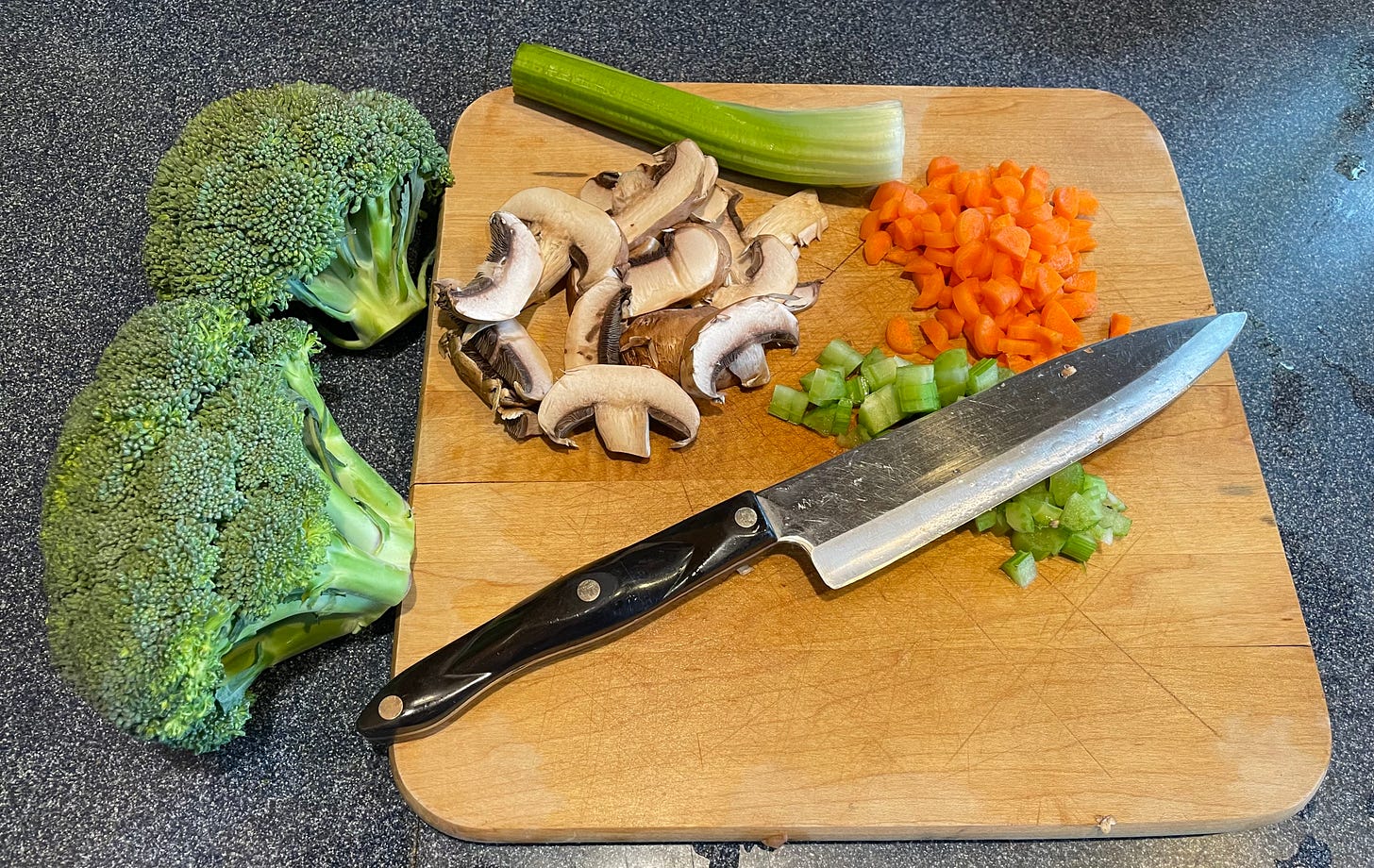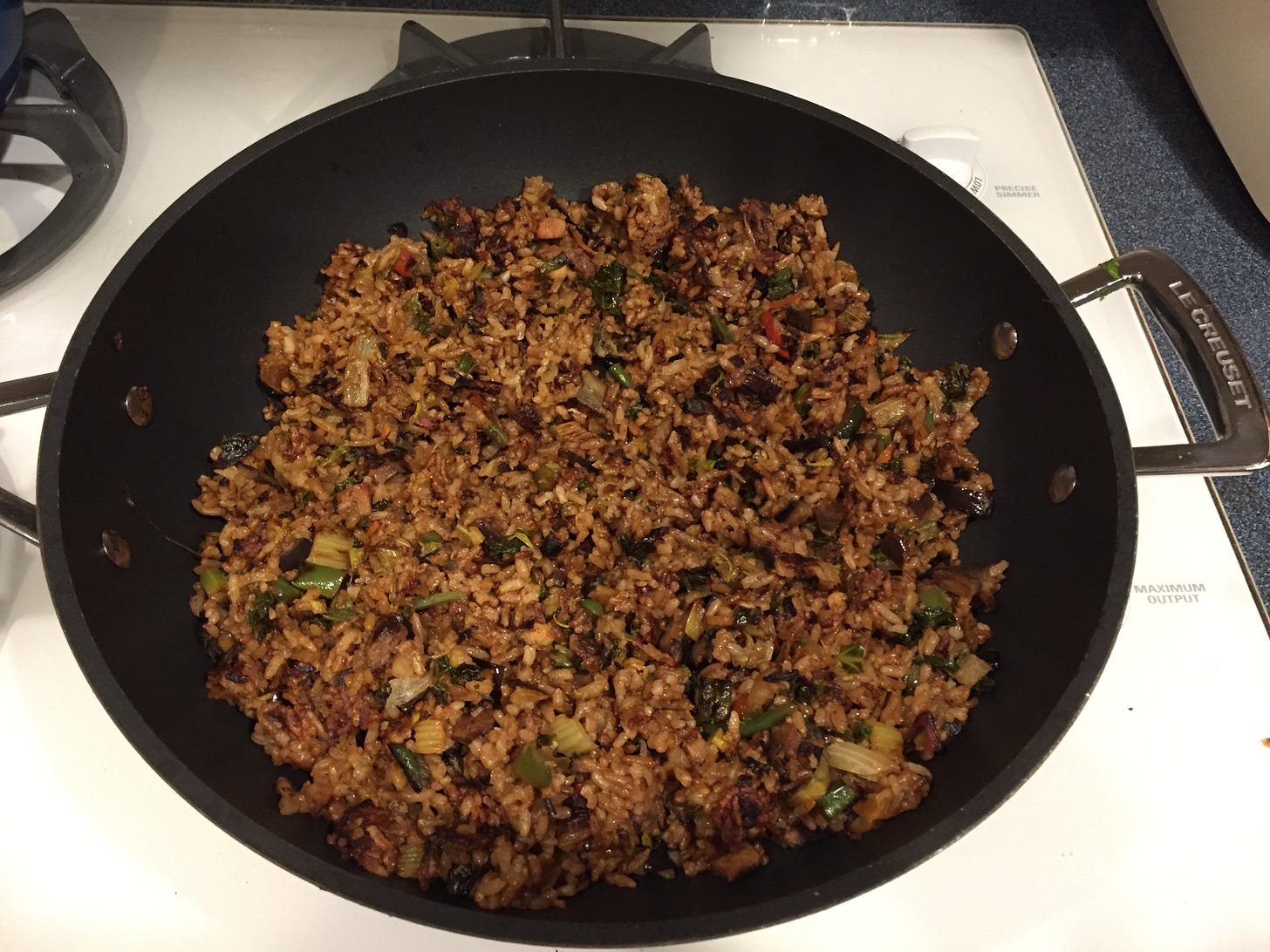Zen Fried Rice: Finding Serenity Bit by Bit
A Kitchen Experience Can Be a Model for Savoring the Moment
By Peter Landry
Whenever we go away for a trip, we try to clean out the refrigerator before we depart. Not with the grab-and-chuck it method. By eating up all the leftovers and perishables before we leave.
This frugality dates back to my nothing-should-be-wasted childhood in Maine, especially the lean years when my dad ran a seasonal business and my mother had not gone back to work.
Good food should be put to good use, my family believed, and even when it went bad, we fed it to the flock of chickens we raised for their eggs.
There’s great satisfaction in making the most of every meal, and even takeout from Chinese or other restaurants.
It’s kind of a Zen thing for me: Be one with the refrigerator.
Early in married life, my wife and I took care of leftovers with a concoction we romantically called “Glop.” It was everything you could imagine — foods of all kinds tossed into a pan or wok, spiced to taste and heated to serving temperature. With a bed of rice and candlelight, it was hearty and heartwarming in a dim and gauzy kind of way.
Later, when I was editing a popular food columnist for a weekly newspaper, I moved on to soups as a way to clear the fridge. The columnist was a woman named Frieda Arkin, who also it turns out was an acclaimed novelist (“The Dorp,” “Hedwig and Berti”). I didn’t know much about her fiction at the time, but I put into practice all I learned by editing her, telling my wife again and again (somewhat obnoxiously) that “Frieda Says …” we should do this or that.
One of the things Frieda said that stuck with me was that “the freezer is your friend” for reducing food waste and living healthier lives. If you can’t eat it now, freeze it, she advised, and make soup later. For years I stockpiled bags of frozen meats and vegetables and when fall came around, tossed them in a soup pot with fresh turkey legs and made delicious turkey soups.
I still use the freezer to stockpile for future soups, but have had to concede that soup is a seasonal delicacy not suited to warmer months. And sometimes I just want a more immediate solution.
Which leads me to Zen Fried Rice.
Long a staple of Chinese restaurants, fried rice is a marvel for using up what you have in the refrigerator. And there are endless variations. It can include fresh or old vegetables, cooked ones or raw, fresh meats or those that have been roasted, broiled or otherwise prepared. It can use ingredients of meals you have made from scratch or those you ordered as takeout (and not just Chinese!).
It’s thrifty and nutritious and a great addition to anyone’s cooking repertoire.
It’s also, to me at least, a Zen experience.
Making fried rice involves lots and lots of chopping, and lots and lots of stirring. The repetition is its beauty, a way to clear the mind and decompress while you focus on the process, step by step. It’s a visual and physical mantra that provides a framework for reflection. It’s mindfulness personified.
It doesn’t matter what order you chop ingredients, but — as with many things in life — it’s important to organize them. Old carrots go in one pile, broccoli stems in another, leftover eggplant in a third and so on.
It’s greatly satisfying to see the piles pile up on plate after plate, marching steadily toward the wok.
And there, an organized approach is even more important. Like the old wine ad, Zen Fried Rice requires that no ingredient be cooked before its time. The raw and hard cook first, because they need to soften the most. Then come the slightly softer, the softer still and, at the end, the softest of all.
When all have been fully softened up, sprinkle a couple cups of cooked rice over the top and mix by turning the edges into the middle. Then — and this is the most important part if you want truly FRIED rice — drizzle soy sauce on top and mix in again.
The soy, I’ve found, is what browns the rice and gives it crunch. Quite simply, it puts the fry in fried (so many restaurants, even Chinese, skip this part and deliver steamed, not fried, rice with vegetables or meat).
Cooking, as Frieda taught me, should be a joy, not a task. It should celebrate the process, not just the end. It should be a journey and an adventure.
Sure, there are times when you just want to prepare something “to put down the food hole,” as a non-cooking colleague once described it.
But in a world gone crazy, cooking can be a source of calm and serenity if you give it time. That may be the most important ingredient of all, since life often seems to suck up time like a sponge.
Zen Fried Rice forces you to slow down, savor the moment, enjoy the process of creating something whole from stray, disjointed parts.
In our house, we call these “never to be repeated” meals, because there’s always something new and fresh about them. They force us to look at things in new ways, focus on the moment and see how small things create a greater whole.
If you think about it, we need that in all aspects of our lives, not just cooking.
If we look only at the big picture, we miss out on the little things that make life richer.
As Frieda might say, find joy in the kitchen — and everywhere else. You’ll be healthier in so many ways, and happier.
TOP PHOTO: Ingredients for Zen Fried Rice, chopped, sorted and organized. BELOW: Truly fried rice, browned and crunchy in the wok.


